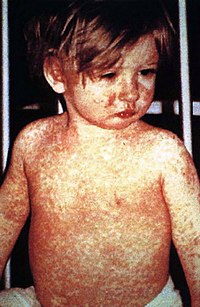
Photo from wikipedia
7020 Background: Histiocytic sarcoma (HS) is a rare and aggressive malignancy of the monocyte/macrophage lineage. There is a paucity of data on treatments and outcomes in HS. Methods: This is… Click to show full abstract
7020 Background: Histiocytic sarcoma (HS) is a rare and aggressive malignancy of the monocyte/macrophage lineage. There is a paucity of data on treatments and outcomes in HS. Methods: This is a retrospective study of patients with histologically confirmed diagnosis of HS from 2000-2018. Kaplan-Meier and log-rank tests were used to perform overall survival (OS) analyses. Hazard ratios (HR) with confidence intervals (CI) were calculated using Cox-proportional hazards. Results: There were 27 patients in the study (median age 59; range 3-83) and 63% were males. Nine had unifocal involvement and 18 had multifocal disease. Common sites involved were lymph node (50%), soft tissue (40%), bone (36%), and bone marrow (22%). Two of 8 patients had the BRAF-V600E mutation. Next-generation sequencing was performed on 8 patients and showed ≥1 oncogenic alterations (DNMT3A, FLT4, KRAS, NRAS, NUP98, PTCH1, PTPN11, TP53, TSC1, PDGFR, or BRAF genes) as well as a CLIP2-BRAF fusion. The median OS for the cohort was 12 months. Factors associated with worse OS included multifocal disease (OS 10 vs. 125 months, p = 0.03; HR 5.0, CI 1.1-21.8) and marrow involvement (OS 3 vs. 43 months, p = 0.003; HR 8.9, CI 1.7-45.0). Twelve (44%) had surgery with median OS of 42 months (range 1-125). Fifteen had chemotherapy with median OS of 12 months (range 2-67; Table). Conclusions: HS is an aggressive neoplasm, with multifocal disease and bone marrow involvement portending worse outcomes. Most patients have somatic oncogenic alterations involving the MAPK-ERK pathway and other genes. Chemotherapeutic regimens have variable response rates but are not durable. More studies on targeted kinase inhibitors in HS are needed to improve outcomes. [Table: see text]
Journal Title: Journal of Clinical Oncology
Year Published: 2019
Link to full text (if available)
Share on Social Media: Sign Up to like & get
recommendations!